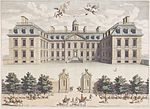Albemarle Street
Art galleries in LondonArt gallery districtsMayfairRoyal InstitutionStreets in the City of Westminster

Albemarle Street is a street in Mayfair in central London, off Piccadilly. It has historic associations with Lord Byron, whose publisher John Murray was based here, and Oscar Wilde, a member of the Albemarle Club, where an insult he received led to his suing for libel and to his eventual imprisonment. It is also known for its art galleries and the Brown's Hotel is located at 33 Albemarle Street.
Excerpt from the Wikipedia article Albemarle Street (License: CC BY-SA 3.0, Authors, Images).Albemarle Street
Albemarle Street, City of Westminster Mayfair
Geographical coordinates (GPS) Address Website Nearby Places Show on map
Geographical coordinates (GPS)
| Latitude | Longitude |
|---|---|
| N 51.5091 ° | E -0.1421 ° |
Address
Brown's Hotel
Albemarle Street 30
W1S 4BP City of Westminster, Mayfair
England, United Kingdom
Open on Google Maps






